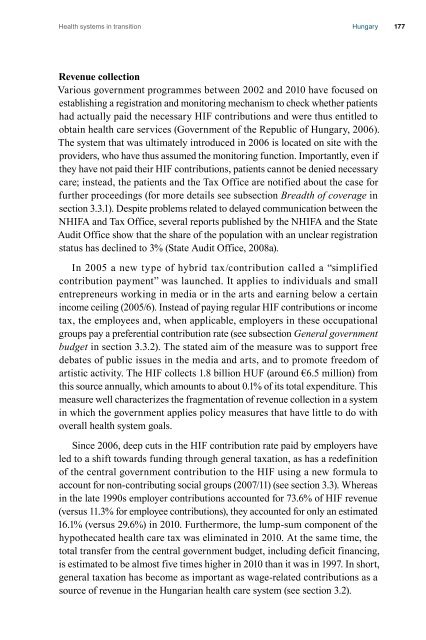Health Systems in Transition - Hungary - World Health Organization ...
Health Systems in Transition - Hungary - World Health Organization ...
Health Systems in Transition - Hungary - World Health Organization ...
Create successful ePaper yourself
Turn your PDF publications into a flip-book with our unique Google optimized e-Paper software.
<strong>Health</strong> systems <strong>in</strong> transition <strong>Hungary</strong> 177<br />
Revenue collection<br />
Various government programmes between 2002 and 2010 have focused on<br />
establish<strong>in</strong>g a registration and monitor<strong>in</strong>g mechanism to check whether patients<br />
had actually paid the necessary HIF contributions and were thus entitled to<br />
obta<strong>in</strong> health care services (Government of the Republic of <strong>Hungary</strong>, 2006).<br />
The system that was ultimately <strong>in</strong>troduced <strong>in</strong> 2006 is located on site with the<br />
providers, who have thus assumed the monitor<strong>in</strong>g function. Importantly, even if<br />
they have not paid their HIF contributions, patients cannot be denied necessary<br />
care; <strong>in</strong>stead, the patients and the Tax Office are notified about the case for<br />
further proceed<strong>in</strong>gs (for more details see subsection Breadth of coverage <strong>in</strong><br />
section 3.3.1). Despite problems related to delayed communication between the<br />
NHIFA and Tax Office, several reports published by the NHIFA and the State<br />
Audit Office show that the share of the population with an unclear registration<br />
status has decl<strong>in</strong>ed to 3% (State Audit Office, 2008a).<br />
In 2005 a new type of hybrid tax/contribution called a “simplified<br />
contribution payment” was launched. It applies to <strong>in</strong>dividuals and small<br />
entrepreneurs work<strong>in</strong>g <strong>in</strong> media or <strong>in</strong> the arts and earn<strong>in</strong>g below a certa<strong>in</strong><br />
<strong>in</strong>come ceil<strong>in</strong>g (2005/6). Instead of pay<strong>in</strong>g regular HIF contributions or <strong>in</strong>come<br />
tax, the employees and, when applicable, employers <strong>in</strong> these occupational<br />
groups pay a preferential contribution rate (see subsection General government<br />
budget <strong>in</strong> section 3.3.2). The stated aim of the measure was to support free<br />
debates of public issues <strong>in</strong> the media and arts, and to promote freedom of<br />
artistic activity. The HIF collects 1.8 billion HUF (around €6.5 million) from<br />
this source annually, which amounts to about 0.1% of its total expenditure. This<br />
measure well characterizes the fragmentation of revenue collection <strong>in</strong> a system<br />
<strong>in</strong> which the government applies policy measures that have little to do with<br />
overall health system goals.<br />
S<strong>in</strong>ce 2006, deep cuts <strong>in</strong> the HIF contribution rate paid by employers have<br />
led to a shift towards fund<strong>in</strong>g through general taxation, as has a redef<strong>in</strong>ition<br />
of the central government contribution to the HIF us<strong>in</strong>g a new formula to<br />
account for non-contribut<strong>in</strong>g social groups (2007/11) (see section 3.3). Whereas<br />
<strong>in</strong> the late 1990s employer contributions accounted for 73.6% of HIF revenue<br />
(versus 11.3% for employee contributions), they accounted for only an estimated<br />
16.1% (versus 29.6%) <strong>in</strong> 2010. Furthermore, the lump-sum component of the<br />
hypothecated health care tax was elim<strong>in</strong>ated <strong>in</strong> 2010. At the same time, the<br />
total transfer from the central government budget, <strong>in</strong>clud<strong>in</strong>g deficit f<strong>in</strong>anc<strong>in</strong>g,<br />
is estimated to be almost five times higher <strong>in</strong> 2010 than it was <strong>in</strong> 1997. In short,<br />
general taxation has become as important as wage-related contributions as a<br />
source of revenue <strong>in</strong> the Hungarian health care system (see section 3.2).
















